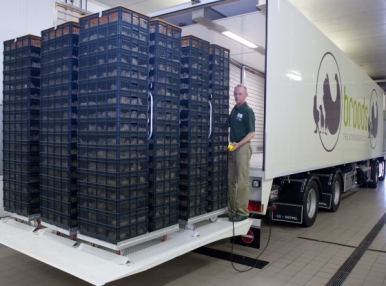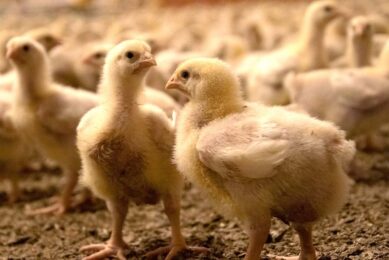Chicks on the move

Day-old chicks will typically travel to the farms where they will spend the majority of their lives. Broiler and layer chicks do not usually travel great distances, unlike PS and GPS chicks. Adequate transport conditions must be created and maintained to allow the birds the greatest chance of arriving on the farm in the best possible condition to get them off to a good, strong start. Keeping body temperature at the optimum level is of particular importance.
By Ron Meijerhof, Poultry Performance Plus, Voorst, the Netherlands
Chick transportation from the hatchery to the farm is an issue that generally does not receive much attention. The main concern, here, is that mortality is kept to a minimum. So long as there is no excessive mortality observed on arrival at the farm, it is considered that the transportation method is acceptable. As the time taken to transport the chicks is often limited to a few hours, it is generally assumed that any damage done in this period will be limited. Only when breeder birds, for instance, are transported over longer distances and greater time spans, do we start to pay closer attention to transportation. But also here is the parameter for good or bad transportation the number of birds dead on arrival.
However, there is much more involved in the transportation of day-old chicks than simply ensuring that they are not dead when they reach the farm. Although the number of dead-on-arrival birds is a very useful indicator for problems, and will be the first and most noticeable factor to observe, we have to realise that there is a whole range of conditions between optimal transportation and killing a bird. If the chicks are not optimally transported, their condition will deteriorate and slowly lead to a situation that is best described as “survival mode”. In this “survival mode”, the chicks are not dead, yet, but they will struggle to stay alive. These are not optimal transportation conditions, and may negatively affect the birds, unnecessarily, once they are on the farm, and also later in life.
Why should we bother?
Conditions during transportation are very important for a number of reasons. Perhaps one of the most important is a factor not often taken into consideration here, and that is simply taking care of the birds, which is an increasing welfare concern. We aim to transport our birds in the most economical way, but we also need to make sure that, within our technical and economical constraints, the animals are comfortable and not at risk of entering the survival mode. In our professional industry, this has become a standard practice, which is a logical and positive development.
It is important to realise that creating optimal transportation conditions is not only important from a welfare point of view, but it has economical advantages as well. It is well known, especially in broilers, that a good and uniform start of the flock is essential for later performance. The first few days of a chicken’s life are important for the development of the bird – a good start and an optimal development in the first week is a crucial factor in achieving good end results. It is easy to imagine that a stressful environment where the birds only just survive will put at least a part of the flock in a retarded condition, thereby making it difficult to start them off properly.
Although broilers are often transported for only a few hours, it is not uncommon to have breeding stock (PS and GPS birds) transported in excess of 24 hours, as they sometimes have to travel to another country or even continent. Although transportation for longer than 24 hours seems very stressful, especially if we compare poultry with other species, for day-old chickens this does not necessarily create a problem if the conditions are optimal.
Bodies in balance
It is essential that the environment in which the chicks are transported is maintained in such a way that the chicks maintain an optimal body temperature of 40°C (104°F). If this is achieved, the birds will feel comfortable and the stress experienced by the birds will be limited. Chicks that are at a comfortable temperature (measured as deep body temperature in the cloaca, or with an infrared ear thermometer on the cloaca) are silent and often asleep. It is surprising how silent the birds will be if an optimal temperature is obtained throughout the flock.
Temperatures that are too low will create stress in the birds, which is evident when they become noisy as they begin to cry. It is said that this is because they are calling for the mother hen to take them under her wings and keep them warm.
Birds that are too warm will also be noisy, but will also spread out their wings to release more heat. If this is not sufficient in cooling the birds (if their body temperature nears 106°F, or 41°C) they will begin panting to release more heat through evaporation. A bird that is comfortable will breathe through its nostrils, and will lose approx. 1-2 g of moisture in 24 hours. As the digestion of the yolk also produces 1-2 g of moisture, they will lose weight but will not become dehydrated. However, if they start panting, they can lose 5-10 g of moisture in 24 hours, which will cause them to become dehydrated very quickly. The relative humidity will decrease the moisture loss, but also their ability to release heat. We can only adequately prevent dehydration by keeping them at the right body temperature.
Creating the right body temperature is a matter of balancing heat produced by the bird with heat lost. Heat production depends on the size of the chick and the age of the breeder, among other factors. Small chicks from young breeder flocks require a higher environmental temperature, because their optimum body temperature is still 40°C, but their heat production is reduced. However, environmental temperature is not a fixed number. If we increase air velocity, the heat that escapes the bird will increase, so their body temperature will rise. This means that an optimal air temperature doesn’t exist, but depends on the heat produced by the chick, and on air velocity. As long as it results in a body temperature of 40°C, it makes no difference to the bird which combination is used.
Nutrition during the first days
Chicks have a residual yolk sac that contains several grammes of essential nutrients. This yolk sac is enough to satisfy their nutritional needs for the first 4-5 days. As the digestion of this yolk sac also generates metabolic water, the birds will not dehydrate if treated properly. This is a very important survival mechanism for birds in nature, as birds are not mammals and cannot supply their offspring with milk. This means that nature prepares chicks for a possible period of shortage before they are able to find food. The residual yolk allows them to overcome that shortage.
This does not mean that birds are better off when they do not have anything to eat, but it does mean that no (welfare) problems are incurred if the birds are without feed during that period. It is well known that birds benefit if they have access to feed and water as quickly as possible. Early feeding stimulates the development of the birds, especially of the intestinal tract. The residual yolk contains approx. 2/3 fat and 1/3 protein. Birds have been created in such a way that if the bird has access to feed, the fat in the residual yolk will supply energy, and the proteins can be used for building up the body, and for functional development. If there is no available feed, the bird will still use the fat from the residual yolk as energy, but it has to use the protein in the yolk for energy as well. As a consequence, the bird will have less protein for early development. This situation, therefore, does not pose a problem, but if we want to maximise the potential of the bird, we have to avoid the situation that the bird uses protein from the residual yolk for energy, which means we have to feed the bird as soon as possible.
Transportation feed
Many people have good experiences with feeding during transportation, but sometimes we see that providing feed directly after hatch doesn’t give the benefits we expect, and may even lead to dehydration. Although this seems surprising, it is a logical consequence of the heat balance that determines body temperature. If we feed birds, heat production increases because they metabolise the nutrients. This is positive, and even helps them to overcome cold conditions on the farm as they “hit the road running”. But if we do not adjust the temperature during transportation, this feeding and metabolising will result in an increase in heat production and therefore an increase in body temperature. As a result, the birds become overheated, feel stressed, begin panting to reduce their body temperature, and consequently dehydrate. This is a good example of the necessity to balance the heat produced by the birds with the heat lost through temperature and air velocity.
Transportation of day-old chicks is a small but significant part of our production chain, not only for breeders but also for broilers and layers. Both from a production perspective as well as from a welfare standpoint, optimising transportation conditions is essential. The main objective is to keep the birds at an optimal body temperature, which is a matter of balancing heat produced with heat lost. Ask any mother what will happen and how she will react if her child is too cold or too warm, and many of the mysteries of chick transportation are solved.
Join 31,000+ subscribers
Subscribe to our newsletter to stay updated about all the need-to-know content in the poultry sector, three times a week. Beheer
Beheer








 WP Admin
WP Admin  Bewerk bericht
Bewerk bericht